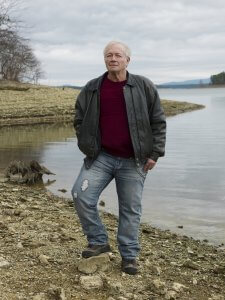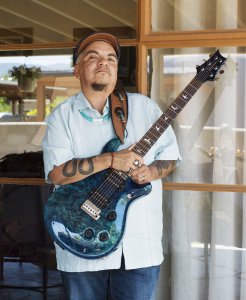By Grace Birnstengel. This article originally appeared on Next Avenue.

Bobbie, 60, of Hanford, Calif., Jay, 59, of New York and Gloria, 70, of Chicago. (Photos: Jess T. Dugan)
Very little history, imagery or understanding of transgender older adults exists in the public sphere. The stories that circulate are often sensationalized, come from a lens of voyeurism or focus on celebrity figures.
To Survive on This Shore: Photographs and Interviews with Transgender and Gender Nonconforming Older Adults, a photography and interview project turned into a book from photographer Jess T. Dugan and social worker Vanessa Fabbre — both based in St. Louis — provides a level of representation previously unseen for this community. The book features 65 portraits of trans older adults between ages 50 and 90. Dugan was the photographer and Fabbre led the interviews with the subjects, who gave the thoughtful and moving quotes featured in the book, which is currently available for pre-order on Amazon (copies will ship Aug. 28).
“We realized this group of older trans adults is really significant for many reasons. Many of them came out prior to the internet, the current conceptualization we have of the trans community or even the word ‘transgender,’” Dugan says. “Many people we photographed and interviewed were significant activists and paved the way for the culture and freedoms we have today. We were worried that this history was at risk of being lost. Our mission was to document it so it would be preserved and people would learn from it going forward.”
The duo intentionally highlighted participants with a diversity of experiences in terms of race and ethnicity, gender identity and expression, sexuality, socioeconomic status, life narrative, age and geographic location — including stories from beyond the places traditionally associated with the LGBTQ community like New York City and Los Angeles. Dugan and Fabbre traveled across the U.S. to small towns and rural places as well as the bigger cities. All of these factors affect the trajectory of a trans person’s life and access to resources and opportunities. To Survive on This Shore is not an all-encompassing collection of trans older adults, but it shows the great breadth of variation from one person to the next and presents a more nuanced approach to storytelling.
“We have people who transitioned in 1970 and also in 2016,” Dugan says.
A Project on the Move

John, 69, of Mount Ida, Ark. (Photo: Jess T. Dugan)
Most of Dugan’s work engages with issues of identity, often focusing on gender, sexuality and LGBTQ communities. This specific project was partially motivated by a photo of hers that went viral on the blogging and social media site Tumblr, where a younger transgender man wrote that he had no visualization for what he would look like as he grew older, and that a photo of Dugan’s gave him this meaningful experience. Though the photo he was reflecting on was not actually of a transgender person, the idea that younger trans people felt they had no visual for older trans people was interesting to Dugan.
“We hope [To Survive on This Shore] is a positive representation for trans people as well as an educational tool and a tool to raise awareness, empathy and understanding,” she says.
The process began in 2013 when Dugan and Fabbre were looking for a way to combine their interests, which had some overlap, and collaborate on a project. The two started interviewing and photographing older trans adults they knew or were connected with.
“If somebody referenced something that was very significant to them, I would try to incorporate that into the portrait somehow,” Dugan says. “John in Arkansas talked about being a big hiker. We sought out this location where he goes hiking to make the portrait. Jay in Albuquerque is also a big hiker, so he wanted to meet in the national forest.”
By 2015, they’d collected portraits and interviews with 20 people around the country, and a write-up in The New York Times “completely exploded the project,” Dugan said. Fabbre and Dugan were flooded with more than 100 emails from people wanting the chance to participate — the chance to be seen and heard.
“There was something very significant about traveling to each person and making the photograph in their space and doing the interview in their home,” Dugan says. Part of the reason the project took so many years to complete was the logistical challenge of photographing and interviewing 88 people around the country. Sixty-five are featured in the book, though all 88 interviews and portraits will live on the project’s website.
Undertold Histories

Grace, 56, of Boston. (Photo: Jess T. Dugan)
Many people featured in the book bring up the experience of being transgender over decades and decades — how some things have changed and how some things haven’t. Jay, a then 59-year-old transgender man from New York who has since passed away, said in the ‘50s and ‘60s, LGBTQ folks were all lumped into the same category. “Society identified me as a lesbian and seemed to ignore my transgender status,” Jay’s passage says.
Similarly, Grace, 56, of Boston, took Fabbre and Dugan through her identity journey and how she has been referred to over a lifetime.
“In the ‘60s, they called me a sissy. In the ‘70s, they called me a faggot. In the ‘80s, I was a queen. In the ‘90s, I was transgender. In the 2000s, I was a woman, and now I’m just Grace,” her passage says.
The powerful firsthand accounts in the book address issues of discrimination and elder abuse in health care and nursing homes; challenging and changing relationships with spouses, children and grandchildren; early trans activism; later-in-life transition (“I missed the first fifty years of my life, but I’m not missing the second fifty,” reads a quote from D’Santi, 54, of Santa Fe) and much, much more.
There is incredible and important learning to be had within the pages of To Survive on This Shore. One common thread that weaves throughout every story: aging and the experience of being older and transgender.
What is ‘Successful Aging’?

D’Santi, 54 of Santa Fe, N.M. (Photo: Jess T. Dugan)
Fabbre — a social worker who wrote her dissertation on trans aging issues — thinks a lot about how we as a society conceptualize and discuss aging.
“I often have my students Google successful aging, and what comes up are these stock images of happy, white, heterosexual couples walking down a beach or perhaps riding bikes through a park together,” she says. “It seems like a very narrow definition of how you’re supposed to live a happy life, and it obscures a lot of identities and social contexts that are complicated for people. I like the images in [To Survive on This Shore] because they offer a more complicated view of who is aging and also what it looks like to be successful or happy in later life.”
Fabbre says that we are quick to ask, “Is this person aging successfully?” when we should be asking a more difficult question: “Is our society facilitating successful aging for everyone?”
“I think there’s a tendency to frame successful aging as a list of top 10 things you can do as an individual to age successfully, but over time it creates this implicit assumption that whether you age well or not is an individual level issue,” Fabbre says. “So then it becomes easy to assume that if someone’s not aging well, it’s their own fault.”
Both Fabbre and Dugan would like To Survive on This Shore to help challenge ideas about trans people and about aging. The ubiquity of getting older creates an opportunity for an audience of people outside of, or unfamiliar with, the transgender community to engage with people within the community.
“So many people speak about wanting to live authentically and having to weigh the risks of living authentically,” Dugan says. “Some people may have only seen media versions of the trans community or negative representations — I think this project allows them an entrance point because the aging element is very relatable.”
Beyond the Book

Charley, 52, of Charlottesville, Va. (Photo: Jess T. Dugan)
At some point in the course of the project, Dugan and Fabbre realized that in the process of photographing and interviewing dozens of older transgender people, they were generating a huge amount of oral history — not all of which would make it in the final, condensed quotes, but all of which should be preserved.
The interviews in their entirety, plus the photographs, will be kept in several LGBTQ archives, and Fabbre will use them in her own research as well.
“I realized that talking to this many people around the country actually formed this dataset that doesn’t exist anywhere else,” Fabbre says. “It felt like a disservice to only use a small quote. I felt compelled to do good research on the interviews, have them continue to live on and have other people read them that may not come across them otherwise.”
Fabbre and Dugan want the book’s distribution and visibility to reach outside of the art world. In the fall of 2017, the Center on Halsted, an LGBTQ center in Chicago, hosted an exhibition of the project organized by the Museum of Contemporary Photography, an event the duo would like to duplicate.
They’ve received interest from nonprofit and LGBTQ groups to use To Survive on This Shore for training purposes. A group in Boston is using the project’s materials to educate older adults about trans older adults they might encounter in senior centers and nursing homes.
“We hope people will use the book for all kinds of reasons and missions,” Dugan says. “We really want people to take it and use it in service with whatever they need or whoever they need to train and educate.”

